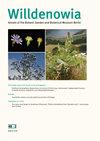Lasioloma antillarum(子囊菌门:Pilocarpaceae),一种来自安的列斯群岛的新地衣真菌,以及公共存储库中序列数据的后验注释的重要性
IF 1.8
3区 生物学
Q2 PLANT SCIENCES
引用次数: 2
摘要
摘要/ Abstract摘要:本文报道了一种来自荷属安的列斯群岛的地衣化真菌:抗lllarum本文章由计算机程序翻译,如有差异,请以英文原文为准。
Lasioloma antillarum (Ascomycota: Pilocarpaceae), a new lichenized fungus from the Antilles, and the importance of posterior annotations of sequence data in public repositories
Abstract: We describe the new lichenized fungus Lasioloma antillarum Lücking, Högnabba & Sipman from the Netherlands Antilles. The new species is characterized by a corticolous growth habit, apothecia with shortly tomentose margins, and rather small (35–50 × 12–16 µm), muriform ascospores in numbers of 2(–4) per ascus. The material had originally been identified as Calopadia phyllogena (Müll. Arg.) Vězda, with associated sequence data, but in phylogenetic analyses consistently fell outside the latter genus. Its revised identification as a species of Lasioloma is consistent with its phylogenetic position and underlines the necessity of posterior annotations in public sequence repositories, in order to correct previous identifications. Citation: Lücking R., Högnabba F. & Sipman H. J. M. 2021: Lasioloma antillarum (Ascomycota: Pilocarpaceae), a new lichenized fungus from the Antilles, and the importance of posterior annotations of sequence data in public repositories. – Willdenowia 51: 83–89. Version of record first published online on 23 March 2021 ahead of inclusion in April 2021 issue.
求助全文
通过发布文献求助,成功后即可免费获取论文全文。
去求助
来源期刊

Willdenowia
PLANT SCIENCES-
CiteScore
4.60
自引率
5.30%
发文量
17
审稿时长
>12 weeks
期刊介绍:
Willdenowia is an international peer-reviewed journal publishing original research articles in English from the entire fields of plant, algal and fungal systematics, covering the evolution, taxonomy and nomenclature of these organisms as well as related fields such as floristics and plant geography. Articles on phylogeny and molecular systematics are especially welcome, as are review articles. Descriptions of new taxa may be considered, but only if supported by robust evidence. Narrowly regional studies of widespread taxa, routine typifications, checklists and new floristic records are generally not considered (excluding contributions to the Euro+Med-Checklist Notulae). Authors are encouraged to deposit duplicates of their material, especially nomenclatural types, in the Berlin herbarium (B).
 求助内容:
求助内容: 应助结果提醒方式:
应助结果提醒方式:


